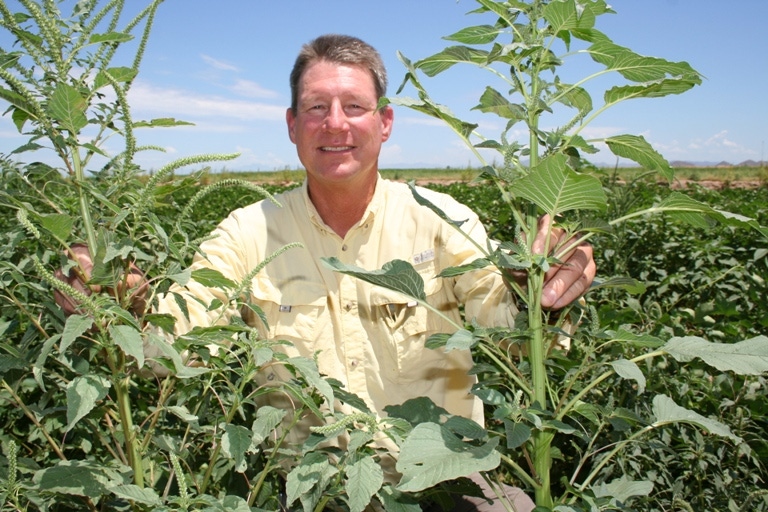
University of Arizona greenhouse assays confirm Palmer amaranth resistance to glyphosate (Roundup) herbicide in cotton in a Buckeye, Ariz., field.For the 2013 cotton season, UA weed scientist Bill McCloskey urges Arizona growers to follow new production practices to reduce the spread of resistance.

It is official: Arizona has its first documented case of herbicide resistance to a weed — Palmer amaranth — and the state’s cotton growers should implement production changes this season.
Bill McCloskey, University of Arizona Extension weed specialist, confirmed the first case of resistance of Palmer amaranth (pigweed), Amaranthus Palmeri, to the herbicide glyphosate (Roundup).
McCloskey made the conclusive finding after a series of UA greenhouse tests with pigweed seed conducted last fall in Tucson.
“I am not surprised that glyphosate resistance was found in Arizona,” McCloskey told a crowd of cotton growers gathered for a UA Extension agronomic workshop in Yuma, Ariz., in January.
“It was only a matter of when,” McCloskey said. “Glyphosate is the predominant weed-management strategy used by Arizona cotton growers year after year.”
Yet McCloskey is surprised that the first Arizona case of resistance was found in cotton. He expected resistance first in tree crops since glyphosate can be applied up to eight times annually for weed control.
The resistance alarm first sounded last summer when a Buckeye cotton grower and several pest control advisers (PCAs) contacted McCloskey. The concern was an 80-acre cotton field with a severe pigweed infestation after several applications of glyphosate.
McCloskey visited the field — plus another suspect field farmed by the same grower about a mile down the road.
McCloskey’s greenhouse tests from December confirmed glyphosate resistance in the first field. In fact, the resistance levels were among the worst found in the U.S.
“It seems to be endemic in the Buckeye area in a wheat-cotton double crop scenario without tillage and pre-emergence herbicides,” McCloskey said. “Roundup was the only herbicide applied during the warm times of the cotton season.”
McCloskey received a call several weeks later from a PCA in Glendale with a problem related to pigweed control with glyphosate. UA greenhouse results were negative for glyphosate resistance.
Buckeye and Glendale are located in Maricopa County in central Arizona, just west of Phoenix.
As the 2013 Arizona cotton planting nears, McCloskey says the spread of the resistance gene depends on production practices utilized by growers. He urges growers to implement production changes to minimize the spread of resistance.
First, start with a clean field. Utilize mechanical tillage at preplant, in-crop cultivation, and post harvest. Hand rogue before seed set. Use multiple herbicides with different modes of action. “The top preseason pigweed control option I recommend is a dinitroaniline (DNA) herbicide application of Prowl, Treflan, or generics,” McCloskey said. “The best way to apply a DNA herbicide is on the flat with a boom on a disk or field cultivator to incorporate the product.”
Zero-tolerance
Adopt a “zero-tolerance” attitude toward any pigweed which escapes treatments in the field or growing on the field margins and nearby drainage areas. This will reduce gene spread into other fields.
“Scout the fields after each herbicide application. If a pigweed escape is found, cut it down,” McCloskey said.
Current crop rotation practiced in the West due to year-round growing conditions helps reduce resistance risks. Crop rotation provides improved herbicide effectiveness through the use of multiple technologies. One of the best rotation options is alfalfa. “Conventional alfalfa is a good rotation choice with cotton in a herbicide-resistant environment,” McCloskey said. “Alfalfa is cut and mowed which reduces the pigweed population.”
Water-run herbicides can help suppress pigweed emergence in alfalfa. Herbicides for winter annual weed control can provide pigweed control in the spring.
The cotton picker is a vehicle to spread resistance by seed. Clean the picker before entering a field. If using a custom harvest service, ask the operator where the picker came from and if it was cleaned afterwards. If not, clean it before entering a new field.
Pigweed seeds are extremely small.
Growers should use existing tools in the herbicide toolbox to control weeds. McCloskey says there is no “magical herbicide with a new mode of action in the pipeline.”
“If a new mode of action was discovered today it would take more than 10 years to bring it to market. The herbicide tools we have now are all we have. We have to make existing herbicides work for a long time.”
One herbicide in Arizona growers’ toolbox is Staple LX. The herbicide was used in cotton fields in the Southeast once glyphosate resistance to pigweed developed. Three years later, pigweed developed a resistance to Staple LX.
McCloskey is unsure if Staple LZ-pigweed resistance could occur in Arizona.
In McCloskey’s greenhouse resistance trials, Staple LX was tested for resistance in the Buckeye and Glendale samples. None was found.
McCloskey shared several points on when to suspect herbicide resistance:
1 – When other causes of herbicide failure are ruled out.
2 – The same herbicide(s) with the same mode of action(s) are used year after year.
3 – One weed species normally controlled is not controlled while other weed species are controlled.
4 – Healthy weeds in the field are mixed with dead weeds of the same species.
5 – A single-species weed patch of uncontrolled plants is spreading.
Arizona costs lower
To implement the production practices mentioned above, McCloskey said these efforts could increase production costs from $20-$40 higher per acre. This amount is lower than cotton production in the Southeast where extra costs can average $50-$60 per acre.
Arizona costs are lower, in part, since growers have more crop options than those in the Southeast. Also — some tillage is already practiced in Western-irrigated agriculture.
How likely could herbicide resistance spread to other Arizona cotton-growing regions? McCloskey said, “Much of it will depend on whether the grower community continues to grow cotton as they have in the past or whether they change their production practices. This is a manageable problem with good management and the use of a wide diversity of tools.”
“This is not a catastrophe for the Arizona cotton industry,” McCloskey said.
Worldwide, glyphosate resistance is found in 24 species of weeds including 13 grasses and 11 broadleaves. In the U.S., there are 15 glyphosate resistant species including eight broadleaves and seven grasses.
The first case of glyphosate resistance in Palmer amaranth was found in a Macon County, Ga., cotton field and reported to the www.weedscience.org website in 2005. Today, most herbicide resistance is widespread throughout the Southeast and Midwest.
McCloskey says resistance can be spread by pigweed pollen and seed. Seed numbers per plant can range from 600,000 seeds to 1.6 million seeds per large plant. An infestation of 1.6 plants per foot of the crop row can produce 600 million seeds per acre.
Seeds can travel at least 1,000 feet.
About the Author(s)
You May Also Like





